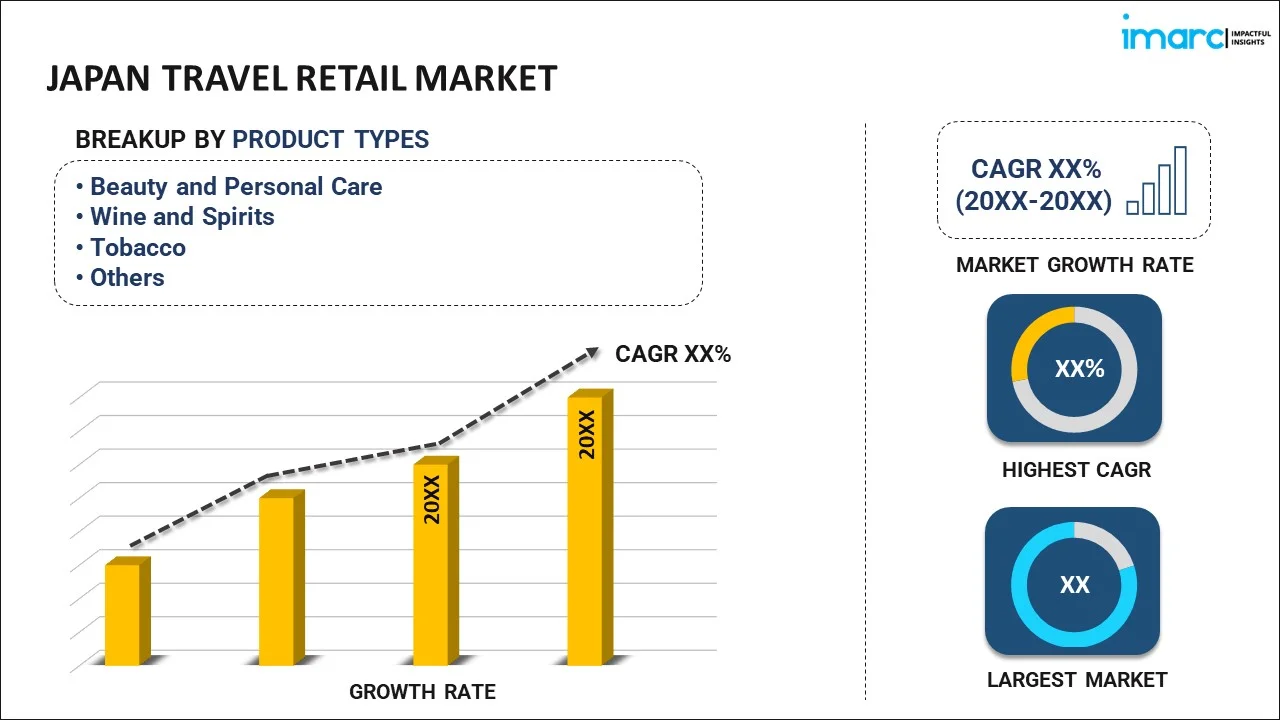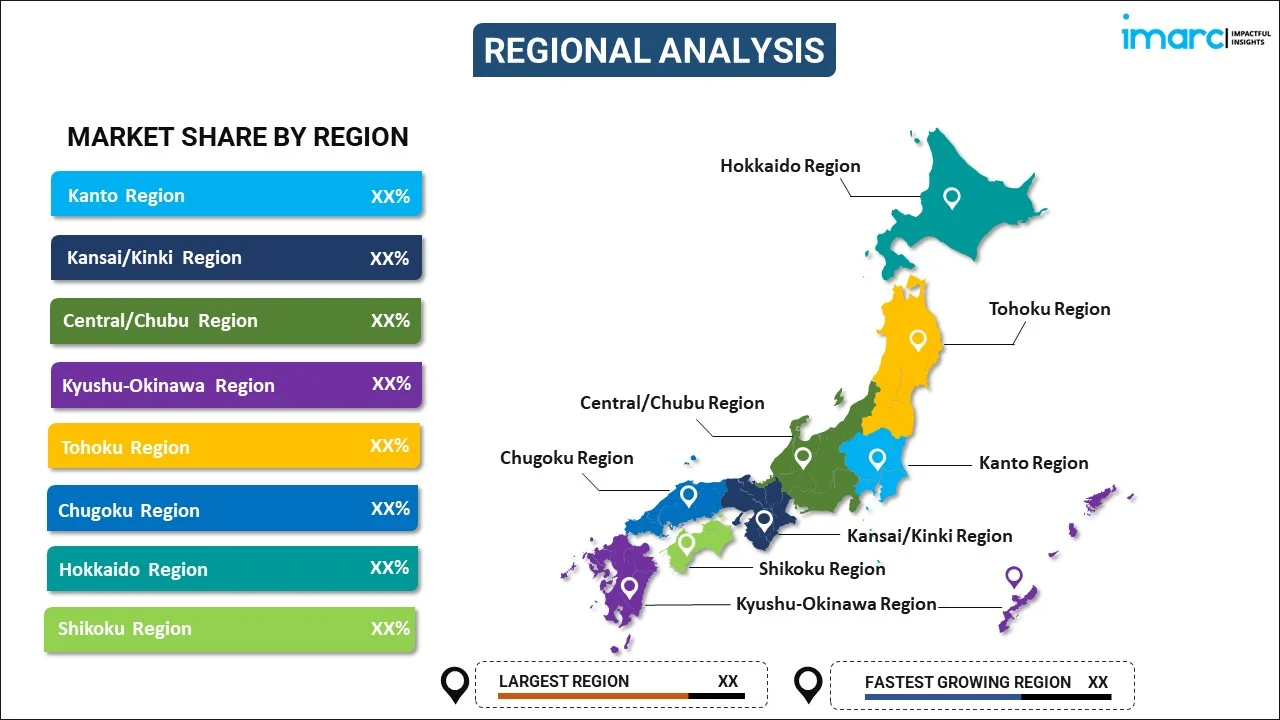
Japan Travel Retail Market Report by Product Type (Beauty and Personal Care, Wine and Spirits, Tobacco, Food and Confectionary, Fashion Accessories and Hard Luxury, and Others), Distribution Channel (Airports, Airlines, Ferries, and Others), and Region 2025-2033
Market Overview:
Japan travel retail market size reached USD 18.8 Billion in 2024. Looking forward, IMARC Group expects the market to reach USD 31.6 Billion by 2033, exhibiting a growth rate (CAGR) of 6% during 2025-2033. The launch of policies by government bodies to promote international tourism, along with the inflating popularity of pre-ordering applications, is primarily driving the market growth.
|
Report Attribute
|
Key Statistics
|
|---|---|
|
Base Year
|
2024 |
|
Forecast Years
|
2025-2033 |
|
Historical Years
|
2019-2024
|
| Market Size in 2024 | USD 18.8 Billion |
| Market Forecast in 2033 | USD 31.6 Billion |
| Market Growth Rate (2025-2033) | 6% |
Travel retail pertains to the transaction of goods and services for travelers while in transit. This commerce typically takes place in transit settings, like airports or harbors, where customers need to show evidence of nationality or journey to enter the shopping zone. The retail outlets also process payments that cover local taxes and duty charges. Additionally, travel retail can be found in hotels, border boats, international flights, ferries, cruises, and other sea vessels on international routes. Items frequently sold in travel retail encompass cosmetics and personal care items, fragrances, high-end spirits, tobacco, edibles and drinks, fashion add-ons, and electronic gadgets. Typically necessitates the buyer to stay abroad for a specified duration, and the retail outlets process payments that encompass both local and national taxes, as well as duty charges.
Japan Travel Retail Market Trends:
The surge in travel and tourism is a primary contributor to the regional market. Travel retail and duty-free outlets constitute a significant chunk of non-aeronautical income for airports, given the growing trend among shoppers to buy upscale and luxurious items during their journeys. In this context, an increasing preference for high-end wines and spirits among global travelers is further fueling the market expansion. Furthermore, the emergence of digital platforms for travel retail is bolstering the market's trajectory. Vendors are extensively showcasing their offerings on online sites and mobile apps, allowing patrons to reserve items ahead and effortlessly retrieve them upon reaching their destination. In addition to this, technological innovations, like the introduction of touchscreen and interactive retail terminals, are acting as significant growth-inducing factors. Moreover, these autonomous terminals foster passenger interaction, delivering streamlined product selection and payment processes. Other driving forces encompass rising consumer spending power and the introduction of supportive government strategies emphasizing international tourism, particularly in emerging economies, signaling a promising growth trajectory for the market.
Japan Travel Retail Market Segmentation:
IMARC Group provides an analysis of the key trends in each segment of the market, along with forecasts at the country level for 2025-2033. Our report has categorized the market based on product type and distribution channel.
Product Type Insights:

- Beauty and Personal Care
- Wine and Spirits
- Tobacco
- Food and Confectionary
- Fashion Accessories and Hard Luxury
- Others
The report has provided a detailed breakup and analysis of the market based on the product type. This includes beauty and personal care, wine and spirits, tobacco, food and confectionary, fashion accessories and hard luxury, and others.
Distribution Channel Insights:
- Airports
- Airlines
- Ferries
- Others
A detailed breakup and analysis of the market based on the distribution channel have also been provided in the report. This includes airports, airlines, ferries, and others.
Regional Insights:

- Kanto Region
- Kansai/Kinki Region
- Central/ Chubu Region
- Kyushu-Okinawa Region
- Tohoku Region
- Chugoku Region
- Hokkaido Region
- Shikoku Region
The report has also provided a comprehensive analysis of all the major regional markets, which include Kanto Region, Kansai/Kinki Region, Central/ Chubu Region, Kyushu-Okinawa Region, Tohoku Region, Chugoku Region, Hokkaido Region, and Shikoku Region.
Competitive Landscape:
The market research report has also provided a comprehensive analysis of the competitive landscape in the market. Competitive analysis such as market structure, key player positioning, top winning strategies, competitive dashboard, and company evaluation quadrant has been covered in the report. Also, detailed profiles of all major companies have been provided.
Japan Travel Retail Market Report Coverage:
| Report Features | Details |
|---|---|
| Base Year of the Analysis | 2024 |
| Historical Period | 2019-2024 |
| Forecast Period | 2025-2033 |
| Units | Billion USD |
| Scope of the Report | Exploration of Historical Trends and Market Outlook, Industry Catalysts and Challenges, Segment-Wise Historical and Future Market Assessment:
|
| Product Types Covered | Beauty and Personal Care, Wine and Spirits, Tobacco, Food and Confectionary, Fashion Accessories and Hard Luxury, Others |
| Distribution Channels Covered | Airports, Airlines, Ferries, Others |
| Regions Covered | Kanto Region, Kansai/Kinki Region, Central/ Chubu Region, Kyushu-Okinawa Region, Tohoku Region, Chugoku Region, Hokkaido Region, Shikoku Region |
| Customization Scope | 10% Free Customization |
| Post-Sale Analyst Support | 10-12 Weeks |
| Delivery Format | PDF and Excel through Email (We can also provide the editable version of the report in PPT/Word format on special request) |
Key Questions Answered in This Report:
- How has the Japan travel retail market performed so far and how will it perform in the coming years?
- What has been the impact of COVID-19 on the Japan travel retail market?
- What is the breakup of the Japan travel retail market on the basis of product type?
- What is the breakup of the Japan travel retail market on the basis of distribution channel?
- What are the various stages in the value chain of the Japan travel retail market?
- What are the key driving factors and challenges in the Japan travel retail?
- What is the structure of the Japan travel retail market and who are the key players?
- What is the degree of competition in the Japan travel retail market?
Key Benefits for Stakeholders:
- IMARC’s industry report offers a comprehensive quantitative analysis of various market segments, historical and current market trends, market forecasts, and dynamics of the Japan travel retail market from 2019-2033.
- The research report provides the latest information on the market drivers, challenges, and opportunities in the Japan travel retail market.
- Porter's five forces analysis assist stakeholders in assessing the impact of new entrants, competitive rivalry, supplier power, buyer power, and the threat of substitution. It helps stakeholders to analyze the level of competition within the Japan travel retail industry and its attractiveness.
- Competitive landscape allows stakeholders to understand their competitive environment and provides an insight into the current positions of key players in the market.
Need more help?
- Speak to our experienced analysts for insights on the current market scenarios.
- Include additional segments and countries to customize the report as per your requirement.
- Gain an unparalleled competitive advantage in your domain by understanding how to utilize the report and positively impacting your operations and revenue.
- For further assistance, please connect with our analysts.
 Inquire Before Buying
Inquire Before Buying
 Speak to an Analyst
Speak to an Analyst
 Request Brochure
Request Brochure
 Request Customization
Request Customization




.webp)




.webp)












